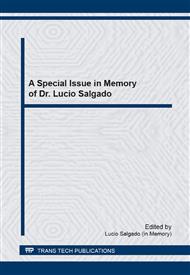[1]
S.T. Coelho: Mechanisms to implement the co-generation of electricity from biomass – A model for the state of São Paulo. Master (Dissertation). São Paulo, 1999. Universidade de São Paulo (USP). (SP). (In Portuguese).
DOI: 10.29381/0103-8559/20192904393-9
Google Scholar
[2]
O. Seye: Analysis of the life-cycle applied to a structural ceramic productive process using elephant grass (Pennicetum purpureum) as energetic content. Master (Dissertation). Campinas, 2003. Universidade Federal de São Carlos (UFSCar). SP. (In Portuguese). SP.
DOI: 10.21115/jbes.v14.suppl2.p180-6
Google Scholar
[3]
D. Lucas and C.T. Benatti: Revista Agronegócios e Meio-Ambiente Vol. 1 (3) (2008), p.405.
Google Scholar
[4]
M. Dondi, M. Marsigli and B. Fabbri: Tile & Brick International 13(4) (1997), p.218.
Google Scholar
[5]
M. Dondi, M. Marsigli and B. Fabbri: Tile & Brick International 13(4) (1997), p.302.
Google Scholar
[6]
D.G. Pinatti, R.A. Conte, M.C. Borlini, B.C. Santos, I. Oliveira, C.M.F. Vieira and S.N. Monteiro: Journal of the European Ceramic Society vol. 26 (3) (2006), p.305.
DOI: 10.1016/j.jeurceramsoc.2004.11.009
Google Scholar
[7]
C.M.F. Vieira and S.N. Monteiro: Rev. Materia Vol. 14 (2009), p.881.
Google Scholar
[8]
C.M.F. Vieira, M.C. Borlini and S.N. Monteiro: Industrial Ceramics Vol. 25 (2006), p.23.
Google Scholar
[9]
A.M.F. Silva, L.S. Lovise, S.N. Monteiro and C.M.F. Vieira: Mater. Sci. Forum Vols 727-728 (2012), p.993.
Google Scholar
[10]
W.D. Kingery, H.K. Bowen and D.R. Uhlmann: Introduction to Ceramics. (John Wiley & Sons, New York, 1975).
Google Scholar
[11]
C.M.F. Vieira, L.F.T. Queiroz and S.N. Monteiro: Mater Sci. Forum Vols 660-661 (2010), p.801.
Google Scholar
[12]
S.N. Monteiro and C.M.F. Vieira: Ceramics International Vol. 30 (2004), p.381.
Google Scholar
[13]
R.R. Menezes, G.A. Neves; H.C. Ferreira: Revista Brasileira de Engenharia Agrícola e Ambiental Vol. 6 (2) (2002), p.303.
Google Scholar
[14]
B.J. Skrifvars, B. Rainer and H. Mikko: Fuel Processing Technology Vol. 56 (1998), p.55.
Google Scholar
[15]
P.E. Praes and M.M. da Silva: Serie de Tecnologia Mineral, CETEM/CNPq, Rio de Janeiro Vol. 71 (1995), p.5.
Google Scholar
[16]
S.A. Silva, A.G. Souza, M.M. Conceição, A.L.S. Alencar, S. Prasad and J.M.O. Cavalheiro: Química Nova Vol. 24 (4) (2001), p.460.
Google Scholar


